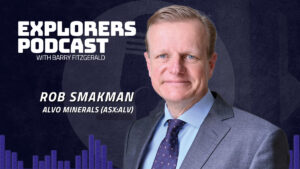Saxo Markets says investors should look beyond the Magnificent 7 for greater global and industry diversity
The online trading platform looked at opportunities in mega cap shares globally beyond the dominant US market
Saxo Markets’ new Global Glorious 10 are diversified companies across countries and industries
In 2023, America’s S&P 500 index surged by 25%, reaching unprecedented levels, while the tech-centric NASDAQ Composite soared by ~45%, spearheaded by the so-called Magnificent 7 — Alphabet, Amazon, Apple, Meta, Microsoft, Nvidia, and Tesla.
Online trading platform Saxo Markets APAC CEO Adam Reynolds told Stockhead the Magnificent 7 are popular with Australian retail investors, but they should start looking further afield for greater diversification, particularly given current volatility.
“The Magnificent 7 as a theme has performed very well but it is a very undiversified group of stocks,” he says.
“They are all US and all very much in the technology space.”
Reynolds says investors should also ensure they have greater diversification beyond the ASX.
According to Reynolds’ calculations, if investors reinvested dividends after investing in the Vanguard Australian Shares Index ETF (ASX:VAS), they would’ve achieved returns of 51% over a five-year period.
VAS is a popular ETF with retail investors seeking exposure to Australia’s largest companies, tracking the S&P/ASX 300 Index (ASX:XKO).
Reynolds says at the same time, investors in the iShares Global 100 ETF (ASX:IOO) who reinvested the dividends, would’ve achieved returns of 117% over five years.
However, he says this is still not as good as his Global Glorious 10.
“I think the key indicator for the benefits of international diversification can be seen in the underperformance of the Aussie ETF over the past five years compared to the global one, or the Global Glorious 10 stocks,” he says.
Reynolds looked at what are the mega cap shares around the world beyond the dominant US market.
In deciding stocks to include, Reynolds looked at companies which had more than a US$50bn market cap, and had seen their price move up 250% or more over the previous five years.
He says that is not necessarily the case for all the stocks on the list now, with some moving back below the 250% with recent market volatility.
“It is a much more diversified group of names from both a geographical and industry sense,” he says.
“There are seven different countries represented including Australia and there are six different industries represented which is a far more diverse portfolio than you would get with the Magnificent 7.”
So what are the stocks on Reynolds’ Global Glorious 10 list?
1. Novo Nordisk – NASDAQ OMX Copenhagen (Denmark), market cap $US561bn*
The Danish pharmaceutical giant Novo Nordisk has for the past century dedicated itself to combatting severe chronic illnesses like diabetes. Notably, its research into a Covid-19 vaccine resulted in the pioneering mRNA vaccine.
Furthermore, Novo Nordisk introduced a ground-breaking treatment called semaglutide for managing type 2 diabetes and aiding in weight loss, which is available under the brands Ozempic and Wegovy.
“It’s dear to our heart because Saxo is also a Danish company,” Reynolds says.
“It’s become well known for its weight loss wonder drugs and grown to be even bigger than the Danish economy and are up more than 400% over the past five years which is an outstanding performance.
“They continue to have strong growth prospects going forward.”
2. ASML Holding NV – Euronext Amsterdam (Netherlands), market cap US$381bn
Reynolds says the Dutch company is the world leader in building the machines that make advanced semiconductors which require ultra-precision and is up more than 400% over the past five years.
According to ASML’s website its “ultraviolet (DUV) lithography systems dive deep into the UV spectrum to print the tiny features that form the basis of the microchip”.
“All of the major semiconductor companies in the world have to buy their machines from ASML so they have a monopoly,” Reynolds says.
“Interestingly the US company Intel was investors in ASML early on and decided not to use their machines.
“Intel was much bigger than ASML when they made that decision and now ASML is much bigger than Intel, which has shrunk in significance.”
3. Hermes International – Euronext Paris (France), market cap US$254bn
Who can resist a luxury French design house, especially one with a regal horse drawn carriage as a logo? With its origins dating back to 1837, Hermes specialises in luxury leather goods, lifestyle accessories, home furnishings, perfumes, jewellery, watches, and clothing.
“They’ve been up more than 280% over the past five years and are very different from Novo Nordisk and ASML so already we have three different countries and three different industries,” Reynolds says.
4. Tokyo Electron – Tokyo Stock Exchange (Japan), market cap US$120bn
Reynolds says Japan is the only country with multiple companies in his Global Glorious 10 list.
“Tokyo Electron is a manufacturer of machines which make semiconductors but is not really a competitor to ASML,” he says.
“They have a different part of the industry and is a name most people would never have heard of before.
“They are the best performer up more than 570% over the past five years and has a very strong position in the semiconductor industry.”
5. Shopify – Toronto Stock Exchange (Canada), market cap US$90.1bn
Reynolds says the Canadian-based multinational e-commerce company is one of the companies which has slipped below a rise of 250% over the past five years and is up ~224% during the period after falls recently.
“Shopify is kind of a competitor to Amazon on a B2B basis and provides a platform for retailers to take their goods to market,” he says.
Reynolds says Shopify has been quite a volatile stock that was performing well in 2023 but has dropped this year.
“Especially with all the tech names pulling back it has been suffering a bit lately,” he says.
6. Hitachi – Tokyo Stock Exchange (Japan), market cap US$88.5bn
Reynolds says Hitachi, which has a more than century-year-history, is a well-known diversified Japanese manufacturing company.
“Hitachi makes all sorts of electronics including trains, computers and so on and is very well-known,” he says.
“It’s up about 300% over the past five years and 100% in the past year.
“Interesting even though Hitachi is such a strong performer its P/E ratio is still only 17.”
The price earnings (P/E) ratio is a widely employed metric for assessing a stock’s value, with a lower P/E ratio typically indicative of greater value.
READ Price Earnings Ratio: How you should (or shouldn’t) use it to find undervalued stocks
7. BYD Company – Shenzhen Stock Exchange (China), market cap $US86.2bn
Reynolds says the electric car manufacturer is taking bites out of Tesla.
“It’s performance over the past one or two years has not been great but it’s still up over 300% over five years,” he says.
“It’s continuing to grow market share and interestingly growing market share outside of China.
“It’s had huge market share in China but is now looking to grow internationally.”
8. Mitsui and Co – Tokyo Stock Exchange (Japan), market cap $US72.4 bn
A name liked by none other than The Oracle of Omaha Warren Buffett, Mitsui and Co is a Japanese trading house.
“It has a very low P/E ratio of 11 and is up 318% over the past five years and is a very high-quality name in a market that’s hot,” Reynolds says.
9. Daiichi Sankyo Co – Tokyo Stock Exchange (Japan), market cap: $US58.1bn
Another Japanese company Daiichi Sankyo is a Japanese biotech focused on research and developing oncology drugs.
“It has slipped back quite a bit recently so is now up 158% in the past five years so is the worst performer in the Global Glorious 10,” Reynolds says.
“Once again though it is a different industry altogether being in biotech and is still a strong performer.”
10. Fortescue (ASX:FMG), market cap $US51.5bn
The Andrew Forrest founded iron ore miner Fortescue (ASX:FMG) also makes Reynolds’ Global Glorious 10.
“Fortescue has also slipped back a bit being very exposed to the iron ore price and is down 216% in the past five years but has a P/E ratio of just 9,” he says.
“However, Fortescue has still had a very strong performance over the years and P/E ratio.”
How to buy the Global Glorious 10
For investors looking to diversify beyond tech and the Magnificent 7, Reynolds says the Global Glorious 10 may warrant further research.
“It’s a no-brainer and it doesn’t make sense to be so concentrated,” he says.
Reynolds says often investors are deterred from buying stocks overseas, thinking about complexity.
However, he says it’s simple with a platform like Saxo.
“It’s simply a case of opening up a trade ticket and hitting buy,” he says.
“We can do multi-currency accounts so you can save on FX (foreign currency) fees.”
*All cited market caps accurate as of 16 April 2024.
The views, information, or opinions expressed in the interview in this article are solely those of the interviewee and do not represent the views of Stockhead. Stockhead has not provided, endorsed or otherwise assumed responsibility for any financial product advice contained in this article.
At Stockhead, we tell it like it is. While Saxo Markets is a Stockhead advertiser, the company did not sponsor this article.
The post Sure the Magnificent 7 are great… but have you seen the ‘Global Glorious 10’? appeared first on Stockhead.






















